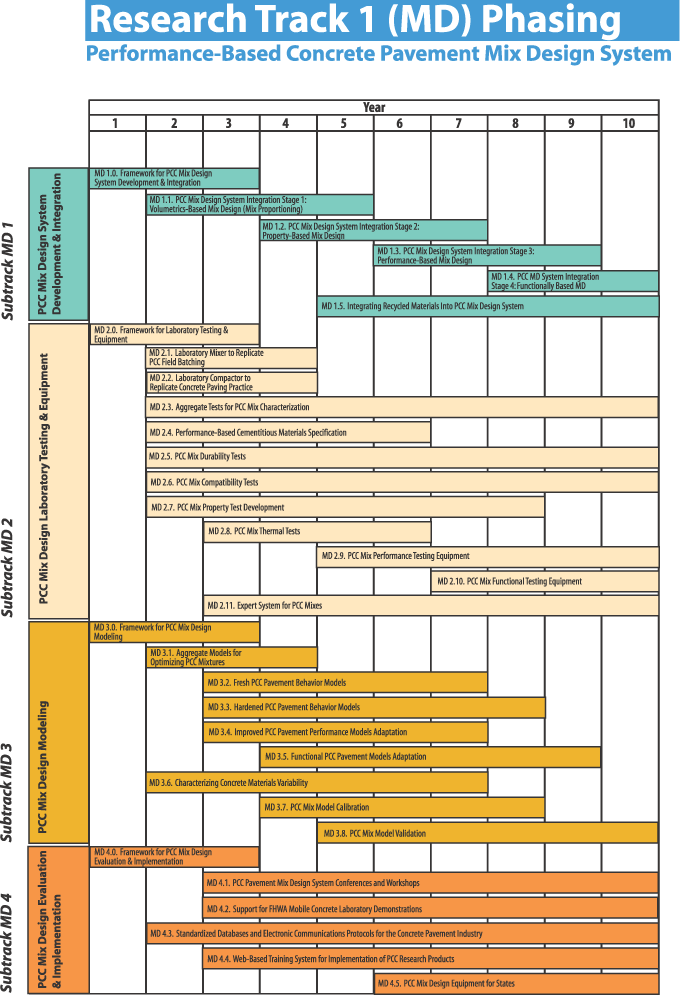U.S. Department of Transportation
Federal Highway Administration
1200 New Jersey Avenue, SE
Washington, DC 20590
202-366-4000
Federal Highway Administration Research and Technology
Coordinating, Developing, and Delivering Highway Transportation Innovations
 |
| This report is an archived publication and may contain dated technical, contact, and link information |
|
Publication Number: FHWA-HRT-05-053 Date: September 2005 |

Figure 1. Bar Chart. Track 1 (MD) subtrack and problem statement phasing chart.
Track 1 (MD) subtrack and problem statement phasing chart.The horizontal bar chart in this figure shows the approximate time phasing of the problem statements in track 1, Performance-Based Concrete Pavement Mix Design System (MD), grouped by subtrack across 10 years. There are four subtracks in track 1: (1) PCC Mix Design System Development and Integration; (2) PCC Mix Design Laboratory Testing and Equipment; (3) PCC Mix Design Modeling; and (4) PCC Mix Design Evaluation and Implementation.
In subtrack 1, the problem statements are arranged as follows: Problem Statement MD 1.0. Framework for PCC Mix Design System Development and Integration extends from years 1 to 3; Problem Statement MD 1.1. PCC Pavement Mix Design System Integration Stage 1: Volumetrics-Based Mix Design (Mix Proportioning) extends from years 2 to 5; Problem Statement MD 1.2. PCC Pavement Mix Design System Integration Stage 2: Property-Based Mix Design extends from years 4 to 7; Problem Statement MD 1.3. PCC Pavement Mix Design System Integration Stage 3: Performance-Based Mix Design extends from years 6 to 9; Problem Statement MD 1.4. PCC Pavement Mix Design System Integration Stage 4: Functionally Based Mix Design extends from years 8 to 10; and Problem Statement MD 1.5. Integrating Recycled Materials into PCC Mix Design System extends from years 5 to 10.
In subtrack 2, the problem statements are arranged as follows: Problem Statement MD 2.0. Framework for PCC Mix Design Laboratory Testing and Equipment extends from years 1 to 3; Problem Statement MD 2.1. Laboratory Mixer to Replicate PCC Field Batching extends from years 2 to 4; Problem Statement MD 2.2. Laboratory Compactor to Replicate Concrete Paving Practice extends from years 2 to 4; Problem Statement MD 2.3. Aggregate Tests for PCC Mix Characterization extends from years 2 to 10; Problem Statement MD 2.4. Performance-Based Cementitious Materials Specifications extends from years 2 to 6; Problem Statement MD 2.5. PCC Mix Durability Tests extends from years 2 to 10; Problem Statement MD 2.6. PCC Mix Compatibility Tests extends from years 2 to 10; Problem Statement MD 2.7. PCC Mix Property Test Development extends from years 2 to 8; Problem Statement MD 2.8. PCC Mix Thermal Tests extends from years 3 to 6; Problem Statement MD 2.9. PCC Mix Performance Testing Equipment extends from years 5 to 10; Problem Statement MD 2.10. PCC Mix Functional Testing Equipment extends from years 7 to 10; and Problem Statement MD 2.11. Expert System for PCC Mixes extends from years 3 to 10.
In subtrack 3, the problem statements are arranged as follows: Problem Statement MD 3.0. Framework for PCC Mix Design Modeling extends from years 1 to 3; Problem Statement MD 3.1. Aggregate Models for Optimizing PCC Mixtures extends from years 2 to 4; Problem Statement MD 3.2. Fresh PCC Pavement Behavior Models extends from years 3 to 7; Problem Statement MD 3.3. Hardened PCC Pavement Behavior Models extends from years 3 to 8; Problem Statement MD 3.4. Improved PCC Pavement Performance Models Adaptation extends from years 3 to 7; Problem Statement MD 3.5. Functional PCC Pavement Models Adaptation extends from years 4 to 9; Problem Statement MD 3.6. Characterizing Concrete Materials Variability extends from years 2 to 7; Problem Statement MD 3.7. PCC Mix Model Calibration extends from years 4 to 8; and Problem Statement MD 3.8. PCC Mix Model Validation extends from years 5 to 10.
In subtrack 4, the problem statements are arranged as follows: Problem Statement MD 4.0. Framework for PCC Mix Design Evaluation and Implementation extends from years 1 to 3; Problem Statement MD 4.1. PCC Pavement Mix Design System Conferences and Workshops extends from years 3 to 10; Problem Statement MD 4.2. Support for FHWA Mobile Concrete Laboratory Demonstrations extends from years 3 to 10; Problem Statement MD 4.3. Standardized Databases and Electronic Communications Protocols for the Concrete Pavement Industry extends from years 2 to 10; Problem Statement MD 4.4. Web-Based Training System for Implementation of PCC Research Products extends from years 3 to 10; and Problem Statement MD 4.5. PCC Mix Design Equipment for States extends from years 6 to 10.